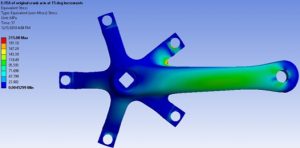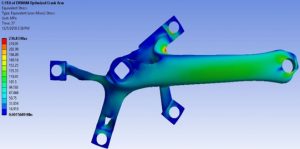Topology Optimization
Topology Optimization in 3D Metal Printing: Direct Metal Laser Sintering (DMLS) is a new technology that can be utilized to create structures that cannot be produced by traditional machining processes. Unlike traditional subtractive manufacturing that removes material to produce a component, additive manufacturing produces parts by adding successive layers. In subtractive manufacturing, cost of a part increases with the amount of material removed due to increased labor time. There is a tradeoff between part cost and part weight. The opposite is true for additive manufacturing – the reducing part weight reduces raw material cost, labor cost, processing time, and weight. As a result, employing topology optimization methods to reduce part weight also reduces cost. Jeremy Smith successfully defended his thesis to use ANSYS finite elements analysis (FEA) and topology optimization software to optimize the design of a 3D metal printed bicycle crank arm. He also employed Design for Metal additive manufacturing guidelines to improve the manufacturability of the design prior to printing. Overall, he achieved a 41% weight reduction and associated cost savings with the new design while maintaining the components ability to carry a load.


Controlling Material Properties using Mesostructures: Terail Conts is designing “materials” in which the elastic modulus can be adjusted. This is being achieved by 3D printing mesostructures within the material. These meso structures are smaller that the overall size of the part so overall part shapes can be achieved. However, they are larger than the microstructure, material grains visible using a microscope. Mesostructures are typically on the order of 0.1 mm to 1.5 mm in size. Unlike foam metal that has a random mesostructure, the mesostructure created by 3D printing can be designed enabling more control of material properties. One application of this research is to enable the ability to create an orthopaedic implant with an elastic modulus that matches that of bone to avoid stress shielding. Moreover, because the material stiffness can be adjusted throughout the structure, areas of higher stress can be stiffened and other areas can be made more compliant.

